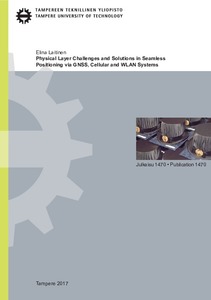Physical Layer Challenges and Solutions in Seamless Positioning via GNSS, Cellular and WLAN Systems
Laitinen, Elina (2017)
Laitinen, Elina
Tampere University of Technology
2017
Teknis-taloudellinen tiedekunta - Faculty of Business and Technology Management
This publication is copyrighted. You may download, display and print it for Your own personal use. Commercial use is prohibited.
Julkaisun pysyvä osoite on
https://urn.fi/URN:ISBN:978-952-15-3942-8
https://urn.fi/URN:ISBN:978-952-15-3942-8
Tiivistelmä
As different positioning applications have started to be a common part of our lives, positioning methods have to cope with increasing demands. Global Navigation Satellite System (GNSS) can offer accurate location estimate outdoors, but achieving seamless large-scale indoor localization remains still a challenging topic. The requirements for simple and cost-effective indoor positioning system have led to the utilization of wireless systems already available, such as cellular networks and Wireless Local Area Network (WLAN). One common approach with the advantage of a large-scale standard-independent implementation is based on the Received Signal Strength (RSS) measurements.
This thesis addresses both GNSS and non-GNSS positioning algorithms and aims to offer a compact overview of the wireless localization issues, concentrating on some of the major challenges and solutions in GNSS and RSS-based positioning. The GNSS-related challenges addressed here refer to the channel modelling part for indoor GNSS and to the acquisition part in High Sensitivity (HS)-GNSS. The RSSrelated challenges addressed here refer to the data collection and calibration, channel effects such as path loss and shadowing, and three-dimensional indoor positioning estimation.
This thesis presents a measurement-based analysis of indoor channel models for GNSS signals and of path loss and shadowing models for WLAN and cellular signals. Novel low-complexity acquisition algorithms are developed for HS-GNSS. In addition, a solution to transmitter topology evaluation and database reduction solutions for large-scale mobile-centric RSS-based positioning are proposed. This thesis also studies the effect of RSS offsets in the calibration phase and various floor estimators, and offers an extensive comparison of different RSS-based positioning algorithms.
This thesis addresses both GNSS and non-GNSS positioning algorithms and aims to offer a compact overview of the wireless localization issues, concentrating on some of the major challenges and solutions in GNSS and RSS-based positioning. The GNSS-related challenges addressed here refer to the channel modelling part for indoor GNSS and to the acquisition part in High Sensitivity (HS)-GNSS. The RSSrelated challenges addressed here refer to the data collection and calibration, channel effects such as path loss and shadowing, and three-dimensional indoor positioning estimation.
This thesis presents a measurement-based analysis of indoor channel models for GNSS signals and of path loss and shadowing models for WLAN and cellular signals. Novel low-complexity acquisition algorithms are developed for HS-GNSS. In addition, a solution to transmitter topology evaluation and database reduction solutions for large-scale mobile-centric RSS-based positioning are proposed. This thesis also studies the effect of RSS offsets in the calibration phase and various floor estimators, and offers an extensive comparison of different RSS-based positioning algorithms.
Kokoelmat
- Väitöskirjat [4764]
